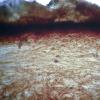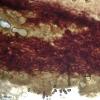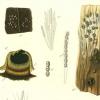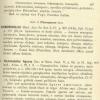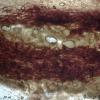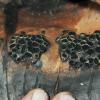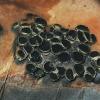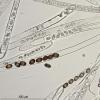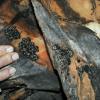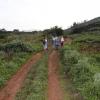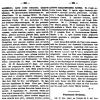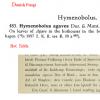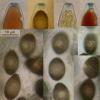
11-10-2012 01:23
Esquivel-Rios EduardoGreetings all.Recently collect this fungus on a de

12-10-2012 00:15
Esquivel-Rios EduardoHi AllPlease i need a┬Ā experts confirmation if th

09-10-2012 16:36
Ren├® DougoudChers Tous,Je recherche l'article suivant:MALENCON

10-10-2012 20:30
Adrian CarterHello Forum:Attached are some photos from dried ma

12-10-2012 11:15
 Michel Hairaud
Michel Hairaud
Bonjour ├Ā tous, Hi to everyone┬ĀCette minuscule h

10-10-2012 01:31
I thought with a good Key they might become a litt

09-10-2012 22:09
Esquivel-Rios EduardoHi All.I found this Poronia in cow dung, have a la

10-10-2012 01:46
This time I am sure I have at last managed to give

07-10-2012 20:58
Esquivel-Rios EduardoHi All.I fond this Hysteriaceae in a dead trunk of
Bulgaria ??
Miguel Ángel Ribes,
29-03-2010 01:30
 Good night
Good nightI have this black asco on Agave americana, from Gran Canaria (Canary Islands), 6 mm diameter, 2 mm tall. Spores eliptical, dark brown, one central gutule, finely warted. Asci cylindrical, inoperculate, IKI+, with croziers. Parafisis cylindrical with yellow gutules.
I do not find anything so (Bulgaria, Durella, Patellaria...)
Sporal measures (1000x, in water, fresh material)
13.1 [14.1 ; 14.4] 15.4 x 8.4 [9.1 ; 9.3] 9.9
Q = 1.4 [1.5 ; 1.6] 1.7 ; N = 80 ; C = 95%
Me = 14.27 x 9.18 ; Qe = 1.56
Thank you
Miguel
Hans-Otto Baral,
30-03-2010 00:09

Re:Bulgaria ??
I have no idea what this is. Nothing to do with Durella or Patellaria for sure, Bulgaria I also do not believe to be closely related. Perhaps more with encoelioid fungi.
Interesting is the thick gel sheath around the spores. The spores appear to be shot when brown.
Bulgariella seems also different in superficial apos without a raised margin (yours appear to be closed when young), and inamyloid asci. The paraphyses would quite fit (yours contain large round VBs when intact). What about the excipulum on the flanks, is it of angularis? In Bulgariella it is of a horizontal prismatica-porrecta, with granular walls.
Zotto
Interesting is the thick gel sheath around the spores. The spores appear to be shot when brown.
Bulgariella seems also different in superficial apos without a raised margin (yours appear to be closed when young), and inamyloid asci. The paraphyses would quite fit (yours contain large round VBs when intact). What about the excipulum on the flanks, is it of angularis? In Bulgariella it is of a horizontal prismatica-porrecta, with granular walls.
Zotto
Miguel Ángel Ribes,
30-03-2010 01:47
Miguel Ángel Ribes,
30-03-2010 01:49
Hans-Otto Baral,
30-03-2010 11:34

Re:Bulgaria ??
Dear Miguel
Your sections are good enough. But there is a wine-red pigment. Did you test with KOH what it does? dissolve in the medium? change its colour?
Zotto
Your sections are good enough. But there is a wine-red pigment. Did you test with KOH what it does? dissolve in the medium? change its colour?
Zotto
Miguel Ángel Ribes,
30-03-2010 12:47

Re:Bulgaria ??
Dear Zotto
No, the photos are made with tap water. I still have ascomas fresh in my fridge, so if you want, today I am going to test it with KOH.
Miguel,
No, the photos are made with tap water. I still have ascomas fresh in my fridge, so if you want, today I am going to test it with KOH.
Miguel,
Hans-Otto Baral,
30-03-2010 16:30

Re:Bulgaria ??
I have no clear idea of the relationship within the Helotiales, therefore any character will be helpful. I also suggest to stain the gel of the spores with cresyl blue in order to see it better. In the case it does not stain I would use indian ink (as far as I know) to see its exact limits of the gel, or phase contrast, or simply by more closing the microscope aperture.
Zotto
Zotto
Miguel Ángel Ribes,
30-03-2010 18:12
Miguel Ángel Ribes,
30-03-2010 18:36
Miguel Ángel Ribes,
30-03-2010 18:39
Hans-Otto Baral,
30-03-2010 22:09

Re:Bulgaria ??
Interesting that the gel does not stain, and that the pigment does not change. Did you add the KOH to the water mount? (you probably lnow the ionomidotic reaction: abundant pigment extrudes in the medium when KOH reaches the tissue).
Did you ask Esperanza about this fungus? The disc is really 6 mm diam?
Zotto
Did you ask Esperanza about this fungus? The disc is really 6 mm diam?
Zotto
Miguel Ángel Ribes,
30-03-2010 23:55

Re:Bulgaria ??
Sorry, I added the KOH directly to the sample, but I just repeat now adding the KOH to the water mount and the results are exactly the same, the pigment is not extrudes.
I have not asked anyone about this Ascomycete. I'm really surprised because their macro features, its large size (I confirm the 6 mm diameter, I have fresh material and I have measure it again), their habitat and so particular micro, made me think the identification would be immediate. ┬┐?
Thanks Zotto, you are very kind, as always.
Miguel
I have not asked anyone about this Ascomycete. I'm really surprised because their macro features, its large size (I confirm the 6 mm diameter, I have fresh material and I have measure it again), their habitat and so particular micro, made me think the identification would be immediate. ┬┐?
Thanks Zotto, you are very kind, as always.
Miguel
Hans-Otto Baral,
31-03-2010 16:15

Re:Bulgaria ??
I was thinking that this species might be introduced from America as the host is Agave. But I do not find that genus in Seaver's (1951) host index.
When I look through Seaver's images, I find only the genus Sphaerangium Seaver (= Phaeangium Sacc. p.pt.) with 3 species. Here the ellipsoid spores become brown and partly have a gel envelope, but are much larger. No mention of an internal pigment, nor the iodine reaction.
Zotto
When I look through Seaver's images, I find only the genus Sphaerangium Seaver (= Phaeangium Sacc. p.pt.) with 3 species. Here the ellipsoid spores become brown and partly have a gel envelope, but are much larger. No mention of an internal pigment, nor the iodine reaction.
Zotto
Miguel Ángel Ribes,
04-04-2010 23:02

Re:Bulgaria ??
Sorry the delay, I have been a long weekend 4 days.
That is a good way, I will find Sphaerangium, but I have not biblio, so it is difficult to identify it for me.
Thanks again Zotto.
That is a good way, I will find Sphaerangium, but I have not biblio, so it is difficult to identify it for me.
Thanks again Zotto.
NC NC,
05-04-2010 12:42
Re:Bulgaria ??
Potrebbe essere Hydnobolus agaves Durieu & Mont. (current name: Conyothrina agaves see Index Fungorum)...In Sylloge Fungorum c'├© un errore ! Devi osservare la tavola 29 f.2 e non 28 f.2 dell'Atlas di Durieu. Ciao
Carlo Agnello,
05-04-2010 12:45
Miguel Ángel Ribes,
05-04-2010 18:05

Re:Bulgaria ??
Hey Carlo, excellent. The macro fits perfectly.
Anyone has micro description?
Thankk you very much,
Miguel
Anyone has micro description?
Thankk you very much,
Miguel
Carlo Agnello,
05-04-2010 18:36

Re:Bulgaria ??
Hi Miguel,
here you can see the complete description of the new combination (1927)
pag. 322, 323, 324
http://bibdigital.rjb.csic.es/ing/Libro.php?Libro=6017
bye
here you can see the complete description of the new combination (1927)
pag. 322, 323, 324
http://bibdigital.rjb.csic.es/ing/Libro.php?Libro=6017
bye
Hans-Otto Baral,
05-04-2010 21:06

Re:Bulgaria ??
This is actually great! I read the description in Saccardo 1889: 587, and this fits very well in spore size and colour. No mention of iodine reaction, or excipular color, see attach.
But there is an error in Index fungorum: Petrak & Sydow 1927 combined a different species, a conidial fungus, Phoma agaves Dur. & Mont., to Coniothyrina, and this is said to be the anamorph of Stomatogene agaves (Ell. & Ev.) Thei├¤ by Petrak & Sydow.
Hymenobolus was described by Montagne in 1845, with H. agaves as monotype, see here:
Zotto
But there is an error in Index fungorum: Petrak & Sydow 1927 combined a different species, a conidial fungus, Phoma agaves Dur. & Mont., to Coniothyrina, and this is said to be the anamorph of Stomatogene agaves (Ell. & Ev.) Thei├¤ by Petrak & Sydow.
Hymenobolus was described by Montagne in 1845, with H. agaves as monotype, see here:
Zotto
Carlo Agnello,
05-04-2010 22:25

Re:Bulgaria ??
Ok Zotto. I initially read the description in Saccardo SF and Montagne but I was wrong to trust IndexFungorum...
Thank you. Bye
Thank you. Bye
Miguel Ángel Ribes,
06-04-2010 00:44

Re:Bulgaria ??
Internet is wonderful and your are very great.
Petrak and Sydow's paper is imposible to me, and Google german translator is really bad. Thanks anyway Carlo, your image (Durieu) is really clear. Papers about Hymenobolus agaves fits Ok, thanks Zotto.
Best regards,
Miguel
Petrak and Sydow's paper is imposible to me, and Google german translator is really bad. Thanks anyway Carlo, your image (Durieu) is really clear. Papers about Hymenobolus agaves fits Ok, thanks Zotto.
Best regards,
Miguel
Hans-Otto Baral,
06-04-2010 13:14

Re:Bulgaria ??
Carlos, did you find Durieu & Montagne on the web or do you have it at home? I would like to look more in this Algerien atlas, what other fungi they have there. Possibly this Hymenobolus has never been recorded again?
Zotto
Zotto
Carlo Agnello,
06-04-2010 17:27

Re:Bulgaria ??
Hello Zotto. Durieu "Atlas - Exploration scientifique de l'Algerie" is available here about 15-16 months ago with many beautiful mushrooms of Leveille and Montagne ...Peziza ammophila, Helvella helvellula, etc. etc... It's so nice that I could not resist printing it ! http://bibdigital.rjb.csic.es/spa/Libro.php?Libro=3962
Ciao
Ciao
Miguel Ángel Ribes,
06-04-2010 18:22

Re:Bulgaria ??
What a wonderful atlas!!
Miguel,
Miguel,
Hans-Otto Baral,
06-04-2010 20:33

Re:Bulgaria ??
Thanks, I downloaded pl. 27-31. Exceptional!
text about ascos is a lot: p. 443-563.
Zotto
text about ascos is a lot: p. 443-563.
Zotto
Guy Garcia,
06-04-2010 20:48
Re:Bulgaria ??
Hi Zotto,
You have a collection in Jaap O. 1915 Siebentes Verzeichnis zu meinem Exsikkatenwerk "Fungi selecti exsiccati". Serien XXV bis XXVIII (Nummern 601-700), nebst Beschreibungen neuer Arten und Bemerkungen. Verh. d. bot. Ver. d. Prov. Brandenb. 57 : 8-25.
But I don't have this paper.
Best, Guy
You have a collection in Jaap O. 1915 Siebentes Verzeichnis zu meinem Exsikkatenwerk "Fungi selecti exsiccati". Serien XXV bis XXVIII (Nummern 601-700), nebst Beschreibungen neuer Arten und Bemerkungen. Verh. d. bot. Ver. d. Prov. Brandenb. 57 : 8-25.
But I don't have this paper.
Best, Guy
Hans-Otto Baral,
06-04-2010 20:52

Re:Bulgaria ??
Hi Guy
I do not know what you mean. Jaap 1915 I do not have in my database, I think I do not have a copy.
What collection do you mean?
Zotto
I do not know what you mean. Jaap 1915 I do not have in my database, I think I do not have a copy.
What collection do you mean?
Zotto
Miguel Ángel Ribes,
06-04-2010 20:54

Re:Bulgaria ??
In Sylloge Fungorum Vol. III, Saccardo, page 317 it appears like Coniothyrium concentricum var. agaves in Italia, Lusitania and Austria. And in page 318 like Coniothyrium agaves, in Argelia.
Miguel,
Miguel,
Guy Garcia,
06-04-2010 21:06
Re:Bulgaria ??
You have a collection "Aus Ûsterreich sind angeführt: 678. Hymenobolus agaves Dur. et Mont. auf Agave, Lesina"
Guy Garcia,
07-04-2010 23:29
Re:Bulgaria ??
Bonsoir Miguel,
Dans le tome 3 du Sylloge il ne s'agit pas de la m├¬me esp├©ce? C'est un Phoma.
Dans le tome 3 du Sylloge il ne s'agit pas de la m├¬me esp├©ce? C'est un Phoma.
Miguel Ángel Ribes,
08-04-2010 15:10

Re:Bulgaria ??
Hello Guy
At Index fungorum and Mycobank appear Coniothyrium agaves like a synonymy of Coniothyrina agaves. Different question is Coniothyrina concentricum var. agaves. Perhaps I am wrong reading the handwritten words at the margin in page 317, n┬║ 67 "probabili... C. agaves (Mont.) Sacc. ... Hispania" and in page 318, n┬║ 70 "An eaden ac var. Agaves Coniothirii concentrici?". Am I wrong?
I am very awkward with taxonomic issues, sorry.
Miguel,
______________________________________________________________
Index fungorum
Coniothyrina agaves (Durieu & Mont.) Petr. & Syd., Repert. Spec. Nov. Regni Veg. Beih. 42(1): 322 (1927) [1926]
Synonymy:
Clisosporium agaves (Mont.) Kuntze, Revis. gen. pl. (Leipzig) 3: 458 (1898)
Coniothyrium agaves (Durieu & Mont.) Sacc., Syll. fung. (Abellini) 3: 318 (1884)
Hymenobolus agaves Durieu & Mont.
At Index fungorum and Mycobank appear Coniothyrium agaves like a synonymy of Coniothyrina agaves. Different question is Coniothyrina concentricum var. agaves. Perhaps I am wrong reading the handwritten words at the margin in page 317, n┬║ 67 "probabili... C. agaves (Mont.) Sacc. ... Hispania" and in page 318, n┬║ 70 "An eaden ac var. Agaves Coniothirii concentrici?". Am I wrong?
I am very awkward with taxonomic issues, sorry.
Miguel,
______________________________________________________________
Index fungorum
Coniothyrina agaves (Durieu & Mont.) Petr. & Syd., Repert. Spec. Nov. Regni Veg. Beih. 42(1): 322 (1927) [1926]
Synonymy:
Clisosporium agaves (Mont.) Kuntze, Revis. gen. pl. (Leipzig) 3: 458 (1898)
Coniothyrium agaves (Durieu & Mont.) Sacc., Syll. fung. (Abellini) 3: 318 (1884)
Hymenobolus agaves Durieu & Mont.
Hans-Otto Baral,
08-04-2010 20:15

Re:Bulgaria ??
In any case, there is a Phoma agaves Durieu & Mont. in Index fungorum, and this is the basionym of Coniothyrina agaves, whereas Hymenobolous agaves has nothing to do with this anamorphic fungus.
Zotto
Zotto
Guy Garcia,
08-04-2010 21:22
Re:Bulgaria ??
Bonsoir,
Comme Zotto l'a d├®j├Ā pr├®cis├® c'est une erreur du site de Kew (index fungorum) reprise par de nombreux autres sites qui copient sans v├®rifier les informations diffus├®es par Kew.
Sur feuilles de Agave americana, Durieu et Montagne ont d├®crit deux champignons bien distincts :
Hymenobolus agaves Durieu & Mont. 1845 Ann. Sci. Nat. s├®r. 3, tome 4 : 360, Atlas pl. 29, f. 2 [typus generis] Ce basionyme n'a pas ├®t├® combin├® dans un autre genre.
Phoma agaves Durieu & Mont. 1856 in Montagne Sylloge generum specierumque Plantarum cryptogamarum p. 271 n┬░980
Comme Zotto l'a d├®j├Ā pr├®cis├® c'est une erreur du site de Kew (index fungorum) reprise par de nombreux autres sites qui copient sans v├®rifier les informations diffus├®es par Kew.
Sur feuilles de Agave americana, Durieu et Montagne ont d├®crit deux champignons bien distincts :
Hymenobolus agaves Durieu & Mont. 1845 Ann. Sci. Nat. s├®r. 3, tome 4 : 360, Atlas pl. 29, f. 2 [typus generis] Ce basionyme n'a pas ├®t├® combin├® dans un autre genre.
Phoma agaves Durieu & Mont. 1856 in Montagne Sylloge generum specierumque Plantarum cryptogamarum p. 271 n┬░980
Miguel Ángel Ribes,
09-04-2010 09:56

Re:Bulgaria ??
Thank you, Guy and Zotto
Now I have understand it, sorry. My species is Hymenobolus agaves Dur. & Mont. (1845).
And Coniothyrina agaves (Phoma agaves, Coniothyrium agaves, Coniothyrium concentricum var. agaves, Coniothyriella agavicola) is another anamorphic species very diferent. Ok.
Ufff. taxonomy is my downfall.
Miguel
Now I have understand it, sorry. My species is Hymenobolus agaves Dur. & Mont. (1845).
And Coniothyrina agaves (Phoma agaves, Coniothyrium agaves, Coniothyrium concentricum var. agaves, Coniothyriella agavicola) is another anamorphic species very diferent. Ok.
Ufff. taxonomy is my downfall.
Miguel
Hans-Otto Baral,
10-04-2010 17:59

Re:Bulgaria ??
Dear Guy & Miguel
I just read the contribution by H├Čhnel 1918 about Hymenobolus. Here the first problems arise. H├Čhnel examined a find from Dalmatia by Jaap (perhaps this belonged to Austria at that time).
Although ascus and spore size fit quite well, H├Čhnel gives the iodine reaction as negative. Variation in iodine reaction occurs sometimes in discomycetes, but a further detail is more surprizing: The ectal excipulum is found to have an outer golden-yellow layer and an inner dark brown layer. The yellow layer is 20-70 ┬Ąm thick and consists of a "waxy" substance in which narrow (1.5-2 ┬Ąm) hyphae are embedded. This layer is said to break easily into clods and detaches, so that mature apothecia show only a yellowish pruina on their exterior. H├Čhnel thought that this could belong in the Pezizales.
On Miguel's photos I see a purplish ectal excipulum, and I remember that KOH did not change the colour. I would not term this brown. So I feel there are some problems in the identity of this collection.
Zotto
I just read the contribution by H├Čhnel 1918 about Hymenobolus. Here the first problems arise. H├Čhnel examined a find from Dalmatia by Jaap (perhaps this belonged to Austria at that time).
Although ascus and spore size fit quite well, H├Čhnel gives the iodine reaction as negative. Variation in iodine reaction occurs sometimes in discomycetes, but a further detail is more surprizing: The ectal excipulum is found to have an outer golden-yellow layer and an inner dark brown layer. The yellow layer is 20-70 ┬Ąm thick and consists of a "waxy" substance in which narrow (1.5-2 ┬Ąm) hyphae are embedded. This layer is said to break easily into clods and detaches, so that mature apothecia show only a yellowish pruina on their exterior. H├Čhnel thought that this could belong in the Pezizales.
On Miguel's photos I see a purplish ectal excipulum, and I remember that KOH did not change the colour. I would not term this brown. So I feel there are some problems in the identity of this collection.
Zotto
Carlo Agnello,
10-04-2010 20:20

Re:Bulgaria ??
Hello everyone.
Are known at least two findings sub Hymenobolus agaves by Portugal (Torrend in Broteria 2:147).
I want to ask what you know about Bulgaria agaves Rabenh. ?
Ciao
Are known at least two findings sub Hymenobolus agaves by Portugal (Torrend in Broteria 2:147).
I want to ask what you know about Bulgaria agaves Rabenh. ?
Ciao
Hans-Otto Baral,
10-04-2010 20:56

Re:Bulgaria ??
Bulgaria agaves Rabenh. is mentioned by H├Čhnel. It is apparently a herbarium name, which means it is invalid. H├Čhnel did not see the specimen nor does he mention its geographical origin, but he considers that it might belong to the same species as Hymenobolus agaves.
Zotto
Zotto
Carlo Agnello,
11-04-2010 06:32
Hans-Otto Baral,
11-04-2010 09:55

Re:Bulgaria ??
You think the purplish changes to brown? Yes, that might be possible. But the yellow in the old herbarium material should be visible in Miguel's material, at least in young apothecia. Together with the iodine reaction I am sceptical about Jaap's collection. So the type of H. agaves could have either the features of Miguel's or those of Jaap's fungus. I do not remember a colour of the excipulum in transmitted light in the protologue. I fear that a type study becomes necessary.
That different though very closely related species inhabit the same host is not very unusual, in my experience.
Finally, the question is still open whether this fungus (or two fungi) originally come from America, i.e. whether they are confined to Agave as substrate. I am also not sure whether this fungus is drought-tolerant, a matter which Miguel could find out (rehydrate the dry specimen and look whether the asci and paraphyses or excipular cells are still alive). Such fungi were often overlooked, maybe also this one in America.
Zotto
That different though very closely related species inhabit the same host is not very unusual, in my experience.
Finally, the question is still open whether this fungus (or two fungi) originally come from America, i.e. whether they are confined to Agave as substrate. I am also not sure whether this fungus is drought-tolerant, a matter which Miguel could find out (rehydrate the dry specimen and look whether the asci and paraphyses or excipular cells are still alive). Such fungi were often overlooked, maybe also this one in America.
Zotto
NC NC,
11-04-2010 13:41
Miguel Ángel Ribes,
11-04-2010 13:46
Miguel Ángel Ribes,
11-04-2010 13:48
Hans-Otto Baral,
11-04-2010 21:44

Re:Bulgaria ??
Nice! How was the fungus found: was it a rainy weather? If not, were the apos dry or moist? Exposed or hidden? Do you have a photo of the situation at the collection site? I mean, do the apos soon get dry as soon as a dry period starts?
You have living (turgescent) asci on your photos. When you rehydrate a dry apothecium and make a careful preparation, you can see whether there are still living asci present. If you are unsure, make photos of them, or test with lethal agents like MLZ or KOH in order to see if they shrink.
I still wonder about the yellow pigment. I feel that the outer layer of the ectal excipulum is made up of much wider hyphae than indicated by H├Čhnel. If you wish you can send me a portion, I would be happy to study this fungus.
On my homepage you see the difference between living and dead asci.
http://www.gbif-mycology.de/HostedSites/Baral/
Zotto
You have living (turgescent) asci on your photos. When you rehydrate a dry apothecium and make a careful preparation, you can see whether there are still living asci present. If you are unsure, make photos of them, or test with lethal agents like MLZ or KOH in order to see if they shrink.
I still wonder about the yellow pigment. I feel that the outer layer of the ectal excipulum is made up of much wider hyphae than indicated by H├Čhnel. If you wish you can send me a portion, I would be happy to study this fungus.
On my homepage you see the difference between living and dead asci.
http://www.gbif-mycology.de/HostedSites/Baral/
Zotto
Miguel Ángel Ribes,
12-04-2010 00:02

Re:Bulgaria ??
I have not the answers to that questions, I am goingo to ask to Vicente Escobio as soon as posible.
Tomorrow I will test the drought-tolerant character and I will send you a portion. of course.
Thank you Zotto.
Miguel,
Tomorrow I will test the drought-tolerant character and I will send you a portion. of course.
Thank you Zotto.
Miguel,
Guy Garcia,
12-04-2010 13:55
Re:Bulgaria ??
Concernant Bulgaria agaves Rabenh., je pense qu'il s'agit d'un nom valide d'apr├©s les renseignements fournis par Saccardo 1892 (Sylloge Fungorum 10 : 42). Le nom a ├®t├® publi├® dans Botanische Zeitung 1849 p. 293 et correspond ├Ā un exsiccatum distribu├® par Klotzsch 1849 (Herbarium vivum mycologicum, Centurie XIII : n┬░ 1223).
De toutes fa├¦ons, si ce n'a pas ├®t├® fait avant, le nom est alors valid├® par Saccardo 1892.
Amiti├®s, Guy
De toutes fa├¦ons, si ce n'a pas ├®t├® fait avant, le nom est alors valid├® par Saccardo 1892.
Amiti├®s, Guy
Miguel Ángel Ribes,
12-04-2010 15:57

Re:Bulgaria ??
This is the answer of Vicente, more or less.
-The weather was not rainy, but quite the oposite because there was a "calima" (dust in the wind), despite being North "median├Łas" about 700 meters above sea level, is always somewhat cooler in such situations. The previous day, in the morning, it had been raining.
-It was a relatively shady and damp place.
-The apotecios were wet.
-Apos were relatively protected because they grow in the area where the pitera leaves are inserted in the plant, i.e. at the widest part of the leaf. There were some leaves above, as a shield.
-Apos were at the top side of the leaves.
-In this moment I have not an habitat photo.
-The apotecios dries quickly. Arriving at Las Palmas at night were wet and fresh, in the morning of the next day semi dried and were dried at noon.
-A very important fact is that leaves were rotting, yellow and very wet in the area where they rot and most fungi were in that area.
Thank you
Miguel
-The weather was not rainy, but quite the oposite because there was a "calima" (dust in the wind), despite being North "median├Łas" about 700 meters above sea level, is always somewhat cooler in such situations. The previous day, in the morning, it had been raining.
-It was a relatively shady and damp place.
-The apotecios were wet.
-Apos were relatively protected because they grow in the area where the pitera leaves are inserted in the plant, i.e. at the widest part of the leaf. There were some leaves above, as a shield.
-Apos were at the top side of the leaves.
-In this moment I have not an habitat photo.
-The apotecios dries quickly. Arriving at Las Palmas at night were wet and fresh, in the morning of the next day semi dried and were dried at noon.
-A very important fact is that leaves were rotting, yellow and very wet in the area where they rot and most fungi were in that area.
Thank you
Miguel
Hans-Otto Baral,
12-04-2010 16:03

Re:Bulgaria ??
I see in Saccardo 1892 that there is no latin diagnosis, so this does not look like a validation. I was unsuccessful to locate Botanische Zeitung 1849: 293 (Not Flora, Allg. Bot. Zeitung).
H├Čhnel said that B. agaves is issued in Rabh. in Klotzsch, but was not supplied by a description. So I assume that H├Čhnel knew about Saccardo, and I agree with him that this material must be restudied in order to find out its identity, though this is not necessary as it is not validly described.
Zotto
H├Čhnel said that B. agaves is issued in Rabh. in Klotzsch, but was not supplied by a description. So I assume that H├Čhnel knew about Saccardo, and I agree with him that this material must be restudied in order to find out its identity, though this is not necessary as it is not validly described.
Zotto
Hans-Otto Baral,
12-04-2010 16:37

Re:Bulgaria ??
Dear Miguel
thanks a lot for this detailed and valuable report. As I understand, the ma^terial was collected on the 17.III.10 and dried under normal conditions within one day. On the 29. III. you presented the fungus. Could you please look in your metadata, when did you make the first microphotos, especially the here attached photo? This shows living asci. If you have rehydrated the apos, then the fungus is clearly desiccation-tolerant, and it will be interesting to note the period of time it survives complete desiccation.
thanks a lot for this detailed and valuable report. As I understand, the ma^terial was collected on the 17.III.10 and dried under normal conditions within one day. On the 29. III. you presented the fungus. Could you please look in your metadata, when did you make the first microphotos, especially the here attached photo? This shows living asci. If you have rehydrated the apos, then the fungus is clearly desiccation-tolerant, and it will be interesting to note the period of time it survives complete desiccation.
Miguel Ángel Ribes,
12-04-2010 17:19

Re:Bulgaria ??
Not exactly. The material was collected on the 17.III.10, Vicente Escobio send me fresh material on the 19.III.10, it arrives fresh at home on the 22.III.10, and the first photos, included the attached by you, are taken on the 23.III.10. So, all my photos are made with fresh material, I have not rehydrated any apos.
Some days later, I do not rememeber exactly, I dried a portion in a Stockli machine, at no more than 35┬║C. This morning I have send you a portion of dried and fresh apos.
Later I am goingo to test the drought-tolerant character.
Vicente has more dried apos, but I do not know how and when are dried.
Miguel,
Some days later, I do not rememeber exactly, I dried a portion in a Stockli machine, at no more than 35┬║C. This morning I have send you a portion of dried and fresh apos.
Later I am goingo to test the drought-tolerant character.
Vicente has more dried apos, but I do not know how and when are dried.
Miguel,
Guy Garcia,
12-04-2010 18:33
Re:Bulgaria ??
Hi Zotto,
The latin diagnosis is only obligate since 1935 !
I don't have the paper of Botanische Zeitnung but i think is't only a listing of the name published by Klotzsch in his Herbarium vivum mycologicum ?
The latin diagnosis is only obligate since 1935 !
I don't have the paper of Botanische Zeitnung but i think is't only a listing of the name published by Klotzsch in his Herbarium vivum mycologicum ?
Hans-Otto Baral,
12-04-2010 19:08

Re:Bulgaria ??
You are right, but any diagnosis is obligatory, I am sure. You never could describe a species without description :-)
In Saccardo there is only the substrate and the herbarium, nothing else.
Zotto
In Saccardo there is only the substrate and the herbarium, nothing else.
Zotto
Martin Bemmann,
12-04-2010 21:04

Re:Bulgaria ??
Hi,
our University Library keeps the Botanische Zeitung and I ordered this volume (reading room only, no copies possible). It will be available to me on 15th. So some patience is necessary ;-)
Cheers,
Martin
our University Library keeps the Botanische Zeitung and I ordered this volume (reading room only, no copies possible). It will be available to me on 15th. So some patience is necessary ;-)
Cheers,
Martin
Miguel Ángel Ribes,
13-04-2010 00:50

Re:Bulgaria ??
Hi again
I have rehidrated an apo with tap water, prepair it with tap water and the asci are alive, paraphysys are medium live (some are turgent with yellow small guttules, but another are not so turgent with big guttules or disgregated pigment). When I add Melzer or KOH 10% the asci shrink a lot, the spores migrate downwards from the apex, and the ascus walls become sinuous, following the contour of the spores.
I send two more pictures of the apos situation inside the agave.
Miguel
I have rehidrated an apo with tap water, prepair it with tap water and the asci are alive, paraphysys are medium live (some are turgent with yellow small guttules, but another are not so turgent with big guttules or disgregated pigment). When I add Melzer or KOH 10% the asci shrink a lot, the spores migrate downwards from the apex, and the ascus walls become sinuous, following the contour of the spores.
I send two more pictures of the apos situation inside the agave.
Miguel
Miguel Ángel Ribes,
13-04-2010 00:59

Re:Bulgaria ??
And now the habitat. Vicente said this:
This is the only picture I have of the area that day. It is the small hill that looks to the right of the photo. It culminates with eucalyptus (E. globulus) and on the slopes are piteras (Agave americana), mugwort (Artemisia thuscula) and laburnum (Adenocarpus foliolosus), and herbs such as thyme (Micromeria varia), houseleeks (Aeonium spp.) and various things. The piteras are in the side of the hill opposite to the photo, where there is a ravine with laurel (Laurus novocanariensis) and some trees such as elm (Ulmus minor) and others. Having laurels in a ravine that is why the area have moisture, but we are talking about a place where it rains more than 700 liters per year, which here is enough.
Thank you,
Miguel
This is the only picture I have of the area that day. It is the small hill that looks to the right of the photo. It culminates with eucalyptus (E. globulus) and on the slopes are piteras (Agave americana), mugwort (Artemisia thuscula) and laburnum (Adenocarpus foliolosus), and herbs such as thyme (Micromeria varia), houseleeks (Aeonium spp.) and various things. The piteras are in the side of the hill opposite to the photo, where there is a ravine with laurel (Laurus novocanariensis) and some trees such as elm (Ulmus minor) and others. Having laurels in a ravine that is why the area have moisture, but we are talking about a place where it rains more than 700 liters per year, which here is enough.
Thank you,
Miguel
Carlo Agnello,
13-04-2010 07:38
Hans-Otto Baral,
13-04-2010 08:27

Re:Bulgaria ??
Thanks Carlo
so on p. 293 near the bottom there is Bulgaria agaves, but without any diagnosis
Zotto
so on p. 293 near the bottom there is Bulgaria agaves, but without any diagnosis
Zotto
Carlo Agnello,
13-04-2010 12:08

Re:Bulgaria ??
I want to tell another find in the hothouses of Copenhagen Botanical Garden.
No description only news in few lines about the finding in:
Danish Fungi as represented in the herbarium of E. Rostrup* (revised by J.Lind) 1915
*Rostrup in Botanisk Tidskrift 22 pag. 254-276 (resume in francais 277-279)
However it is a very beautiful mushroom and, thanks to Miguel, I'll be attentive to all Agave plants that meet.
Ciao
No description only news in few lines about the finding in:
Danish Fungi as represented in the herbarium of E. Rostrup* (revised by J.Lind) 1915
*Rostrup in Botanisk Tidskrift 22 pag. 254-276 (resume in francais 277-279)
However it is a very beautiful mushroom and, thanks to Miguel, I'll be attentive to all Agave plants that meet.
Ciao
Gernot Friebes,
13-04-2010 13:20
Re:Bulgaria ??
Hi,
the isotype of Bulgaria agaves can be found in the Herbarium Hamburgense, just in case you would like to check the material. Here you can see the list of fungi of the herbarium on the internet: http://www.biologie.uni-hamburg.de/bzf/herbar/hbg_fungi_a.htm#B (number 2244).
Best wishes,
Gernot
the isotype of Bulgaria agaves can be found in the Herbarium Hamburgense, just in case you would like to check the material. Here you can see the list of fungi of the herbarium on the internet: http://www.biologie.uni-hamburg.de/bzf/herbar/hbg_fungi_a.htm#B (number 2244).
Best wishes,
Gernot
Carlo Agnello,
13-04-2010 19:22

Re:Bulgaria ??
This Isotype does not refer to Hymenobolus agaves but Hymenobolus carniolicus (What's carniolicus ????? An error ????)
In my opinion, if there an holotypus from Alger must look at Paris, where there is material of Montagne, Leveille, Durieu...
Ciao
In my opinion, if there an holotypus from Alger must look at Paris, where there is material of Montagne, Leveille, Durieu...
Ciao
Hans-Otto Baral,
13-04-2010 20:32

Re:Bulgaria ??
You are right, but in HBG there is Hymenobolus agaves (3x), H. carniolicus (type), and Bulgaria agaves (type). Regrettably there are no author citations.
In IF we have in addition Hymenobolus kmetii Rehm (1905); Helotiales, on Quercus from HUngary. This species is described with a thick gel sheath around the spores (!) which are much larger (25 x 18 ┬Ąm). Asci 4spored, no iodine reaction given.
The third is the myxomycete.
So Hymenobolus is an endless story, as many.
Zotto
In IF we have in addition Hymenobolus kmetii Rehm (1905); Helotiales, on Quercus from HUngary. This species is described with a thick gel sheath around the spores (!) which are much larger (25 x 18 ┬Ąm). Asci 4spored, no iodine reaction given.
The third is the myxomycete.
So Hymenobolus is an endless story, as many.
Zotto
Hans-Otto Baral,
18-04-2010 10:29

Re:Bulgaria ??
News on Hymenobolus: I have studied the specimen kindly sent by Miguel. The fresh part was in quite a bad state, though the spores survived well, but the asci were somewhat vanished. In the dry part the asci were in very good shape, but all dead. So it seems the fungus is not desiccation-tolerant, at least when being dry for ca. 23 days (dried at 35┬░C).
I was surprized that the brown colour of the spores is mainly in very discrete though quite small warts which make the contour of the spores distinctly roughened.
I attach images.
Zotto
I was surprized that the brown colour of the spores is mainly in very discrete though quite small warts which make the contour of the spores distinctly roughened.
I attach images.
Zotto
Nicolas VAN VOOREN,
18-04-2010 19:45

Re:Bulgaria ??
Just a simple comment about "H├Čhnel said that B. agaves is issued in Rabh. in Klotzsch, but was not supplied by a description. So I assume that H├Čhnel knew about Saccardo, and I agree with him that this material must be restudied in order to find out its identity, though this is not necessary as it is not validly described."
The name published in exsiccata series could be validly published after the ICBN art. 30.4 (http://ibot.sav.sk/icbn/frameset/0034Ch4Sec1a030.htm). So I think the name Bulgaria agaves Rabenh. is valid, but it doesn't mean that this species has the same type of Hymenobolus agaves...
The name published in exsiccata series could be validly published after the ICBN art. 30.4 (http://ibot.sav.sk/icbn/frameset/0034Ch4Sec1a030.htm). So I think the name Bulgaria agaves Rabenh. is valid, but it doesn't mean that this species has the same type of Hymenobolus agaves...
Hans-Otto Baral,
19-04-2010 13:02

Re:Bulgaria ??
Hi Nicolas,
yes, you are right, it is necessary to ask someone to look for the label. If the label contains a printed or copied diagnosis in all the duplicates, then B. agaves is validly published.
I arrived at a Czech site when clicking on your given address. Maybe this one is better:
http://ibot.sav.sk/icbn/main.htm
Zotto
yes, you are right, it is necessary to ask someone to look for the label. If the label contains a printed or copied diagnosis in all the duplicates, then B. agaves is validly published.
I arrived at a Czech site when clicking on your given address. Maybe this one is better:
http://ibot.sav.sk/icbn/main.htm
Zotto
Carlo Agnello,
19-04-2010 20:49

Re:Bulgaria ??
Hi Zotto,
your picture is very, very beautyful.
Montagne in diagnosis of the genus says: "sporis simplicibus atris utroque fine obscurioribus referti"
Ciao, Carlo
your picture is very, very beautyful.
Montagne in diagnosis of the genus says: "sporis simplicibus atris utroque fine obscurioribus referti"
Ciao, Carlo
Miguel Ángel Ribes,
20-04-2010 00:41

Re:Bulgaria ??
Hi Zotto, great picture.
So, more or less, 14-18 days after been dried at 35┬║C, paraphysis are mostly died and asci are alive; but at 23 days are died asci too. How much is the time to said a fungi is desiccation-tolerant?
With all this data, are you thinking in Hymenobolus agaves or is it any doubth?
Thanks a lot of, Zotto.
Miguel,
So, more or less, 14-18 days after been dried at 35┬║C, paraphysis are mostly died and asci are alive; but at 23 days are died asci too. How much is the time to said a fungi is desiccation-tolerant?
With all this data, are you thinking in Hymenobolus agaves or is it any doubth?
Thanks a lot of, Zotto.
Miguel,
Hans-Otto Baral,
20-04-2010 11:24

Re:Bulgaria ??
Hi
Miguel. did you observe livin asci after rehydration? I remmeber you said you received apos fresh, and from these the micro with the turgescent asci comes.
There is no sharp limit between tolerant and sensitive. But if all elements of an apo are alive after being one day completely dry, we can safely speak of a desicccation-tolerant fungus, in my opinion.
I suggest to locate the type material of H. agaves, mainly in order to confirm the warted spores and amyloid asci.
Carlo: do you understand the latin sentence? I translate: "asci cylindrical, filled with spores simple (i.e. aseptate), black, at both ends or halves finally darker". Nothing about warts. But I strongly assume that the warts were overlooked.
Zotto
Miguel. did you observe livin asci after rehydration? I remmeber you said you received apos fresh, and from these the micro with the turgescent asci comes.
There is no sharp limit between tolerant and sensitive. But if all elements of an apo are alive after being one day completely dry, we can safely speak of a desicccation-tolerant fungus, in my opinion.
I suggest to locate the type material of H. agaves, mainly in order to confirm the warted spores and amyloid asci.
Carlo: do you understand the latin sentence? I translate: "asci cylindrical, filled with spores simple (i.e. aseptate), black, at both ends or halves finally darker". Nothing about warts. But I strongly assume that the warts were overlooked.
Zotto
Miguel Ángel Ribes,
20-04-2010 14:30

Re:Bulgaria ??
Hi Zotto
At 13/04/09 I wrote this, perhaps the message did not arrive or my english is very very bad, sorry: "I have rehidrated an apo with tap water, prepair it with tap water and the asci are alive, paraphysys are medium live (some are turgent with yellow small guttules, but another are not so turgent with big guttules or disgregated pigment). When I add Melzer or KOH 10% the asci shrink a lot, the spores migrate downwards from the apex, and the ascus walls become sinuous, following the contour of the spores.".
This is the calendar of the events:
- 17/3: Vicente find the fungi at Gran Canaria
- 19/3: Vicente send me the fungi (fresh fungi)
- 22/3: The fungi arrives at home (fresh)
- 23/3: I study it at micro and take pictures (fresh/turgescent fungi)
- 25/3-28/3, (more or less, I do not remember exactly): I dehydrated a portion at 35┬║C
- 29/3: I send the fungi to Ascofrance
- 13/4: I rehydrated one apo in tap water, paraphysis are semi dead and asci are alive
- 16/4: I send you dried and fresh apos.
- 18/4: You study it and dried apos are dead
In other hands, I have never ask for a type material. Is it easy? Could I made it or it must be done by an "oficial body"?
Thanks a lot, Zotto.
Miguel,
At 13/04/09 I wrote this, perhaps the message did not arrive or my english is very very bad, sorry: "I have rehidrated an apo with tap water, prepair it with tap water and the asci are alive, paraphysys are medium live (some are turgent with yellow small guttules, but another are not so turgent with big guttules or disgregated pigment). When I add Melzer or KOH 10% the asci shrink a lot, the spores migrate downwards from the apex, and the ascus walls become sinuous, following the contour of the spores.".
This is the calendar of the events:
- 17/3: Vicente find the fungi at Gran Canaria
- 19/3: Vicente send me the fungi (fresh fungi)
- 22/3: The fungi arrives at home (fresh)
- 23/3: I study it at micro and take pictures (fresh/turgescent fungi)
- 25/3-28/3, (more or less, I do not remember exactly): I dehydrated a portion at 35┬║C
- 29/3: I send the fungi to Ascofrance
- 13/4: I rehydrated one apo in tap water, paraphysis are semi dead and asci are alive
- 16/4: I send you dried and fresh apos.
- 18/4: You study it and dried apos are dead
In other hands, I have never ask for a type material. Is it easy? Could I made it or it must be done by an "oficial body"?
Thanks a lot, Zotto.
Miguel,
Hans-Otto Baral,
20-04-2010 15:55

Re:Bulgaria ??
Dear Miguel
your english is good enough indeed. But you mean 13.04.10? By email? No, sorry, I did not receive such mail. The last mail I receievd from you dates 10.04.
Did you make photos of the rehydrated material?
I fear I need to order the material myself, but I do not know when to do. Yes, it must be an official institution for most herbaria, if you wish to order material.
Zotto
your english is good enough indeed. But you mean 13.04.10? By email? No, sorry, I did not receive such mail. The last mail I receievd from you dates 10.04.
Did you make photos of the rehydrated material?
I fear I need to order the material myself, but I do not know when to do. Yes, it must be an official institution for most herbaria, if you wish to order material.
Zotto
Carlo Agnello,
20-04-2010 16:36

Re:Bulgaria ??
I Zotto,
IŌĆÖm not Latinist.
Here, one has the impression that Montagne other had to say on the pigment of these spores...
The phrase ŌĆ£sporis simplicibus atris utroque fine obscurioribus refertiŌĆØ seems unusually long for the old descriptionsŌĆ”Usually we read ŌĆ£laevisŌĆØ and ŌĆ£sporis atrisŌĆØ or ŌĆ£brunneisŌĆØ or ŌĆ£fuscisŌĆØŌĆ”
The interpretation that I do is: spore lisce scure - in entrambe i lati osservate finemente pi├╣ scure.
ItŌĆÖs not easy but in English should be: spores smooth brown - on both sides observed finely darkerŌĆ”
But obviously this is my translation / interpretation might be wrong !
Then realistically, by the means of 1843, he could not see too small roughnessŌĆ”But perhaps only not clearly !
Ciao, Carlo
IŌĆÖm not Latinist.
Here, one has the impression that Montagne other had to say on the pigment of these spores...
The phrase ŌĆ£sporis simplicibus atris utroque fine obscurioribus refertiŌĆØ seems unusually long for the old descriptionsŌĆ”Usually we read ŌĆ£laevisŌĆØ and ŌĆ£sporis atrisŌĆØ or ŌĆ£brunneisŌĆØ or ŌĆ£fuscisŌĆØŌĆ”
The interpretation that I do is: spore lisce scure - in entrambe i lati osservate finemente pi├╣ scure.
ItŌĆÖs not easy but in English should be: spores smooth brown - on both sides observed finely darkerŌĆ”
But obviously this is my translation / interpretation might be wrong !
Then realistically, by the means of 1843, he could not see too small roughnessŌĆ”But perhaps only not clearly !
Ciao, Carlo
Miguel Ángel Ribes,
20-04-2010 19:06

Re:Bulgaria ??
Dear Zotto
Sorry, exactly 13.04.2010, not 2009. But not by private email, here, in Ascofrance. Is not there more messages from me in Ascofrance since 10.04.2010?
From 10.04.2010 I have sent theese messages (I attach a pdf with entire conversation):
- 11.04.2010: 3 messages:
- "I have this "in situ" ...", with one picture
- "The second one...", with one picture
- "And the last one...", with one picture
- 12.04.2010: 3 messages:
- "I have not answer..."
- "This is the answer..."
- "Not exactly. The..."
- 13.01.2010: 3 messages:
- "Hi again. I have rehidrated..."
- "One more...", with one picture
- "And now the habitat...", with one picture
- 20.04.2010: 1 message: "Hi Zotto, great picture..."
I did not make photos with rehydrated material, but I added KOH and Melzer to several tap water samples and observed a great asci shrink.
Miguel,
Sorry, exactly 13.04.2010, not 2009. But not by private email, here, in Ascofrance. Is not there more messages from me in Ascofrance since 10.04.2010?
From 10.04.2010 I have sent theese messages (I attach a pdf with entire conversation):
- 11.04.2010: 3 messages:
- "I have this "in situ" ...", with one picture
- "The second one...", with one picture
- "And the last one...", with one picture
- 12.04.2010: 3 messages:
- "I have not answer..."
- "This is the answer..."
- "Not exactly. The..."
- 13.01.2010: 3 messages:
- "Hi again. I have rehidrated..."
- "One more...", with one picture
- "And now the habitat...", with one picture
- 20.04.2010: 1 message: "Hi Zotto, great picture..."
I did not make photos with rehydrated material, but I added KOH and Melzer to several tap water samples and observed a great asci shrink.
Miguel,
Hans-Otto Baral,
20-04-2010 19:21

Re:Bulgaria ??
Oh, that's interesting that Ascofrance can be listed like this. Where is the button to do this? I searched in it for Vicente but I found only your contribution from today.
Zotto
Zotto
Miguel Ángel Ribes,
20-04-2010 19:58

Re:Bulgaria ??
It is simply a functionality of your Internet Browser: Archive -> Print, and in Printer you must choose "Adobe pdf" or "Acrobat distiller" or similar to generate a pdf. If you do not have any pdf software, you can print it directly to your printer.
Miguel
Miguel
Miguel Ángel Ribes,
20-04-2010 20:45

Re:Bulgaria ??
I have just repeat the test rehydrating an apo with tap water, adding Melzer, and the asci are dead. Now there is not any shrink.
Miguel,
Miguel,

 10909.pdf
10909.pdf


